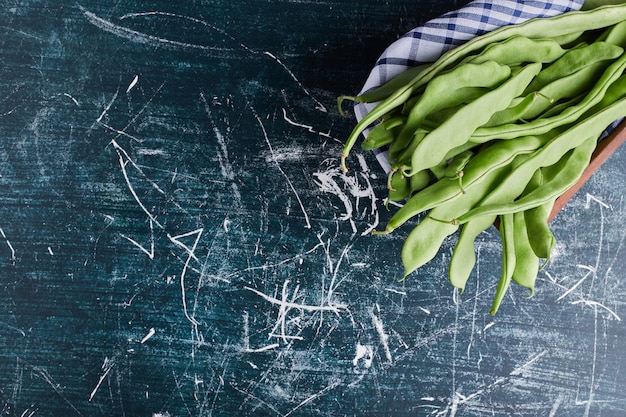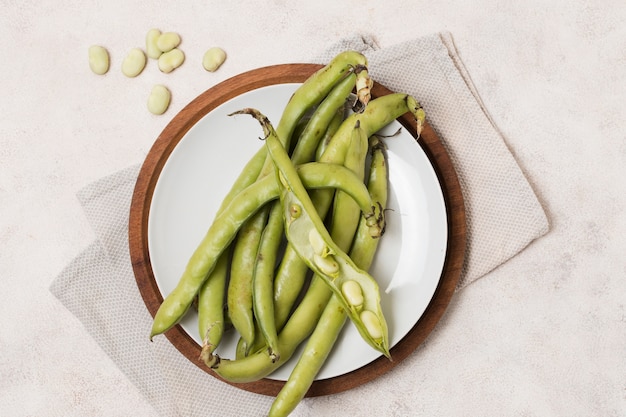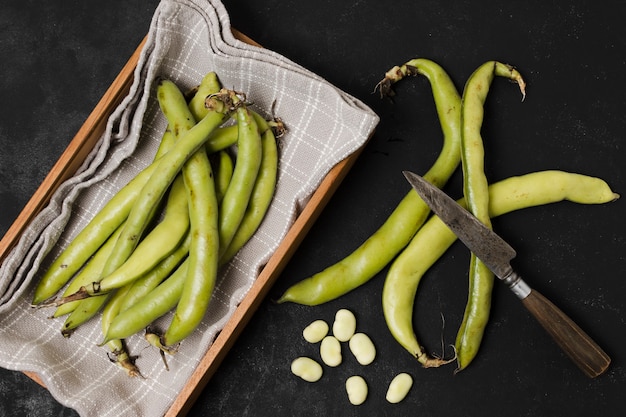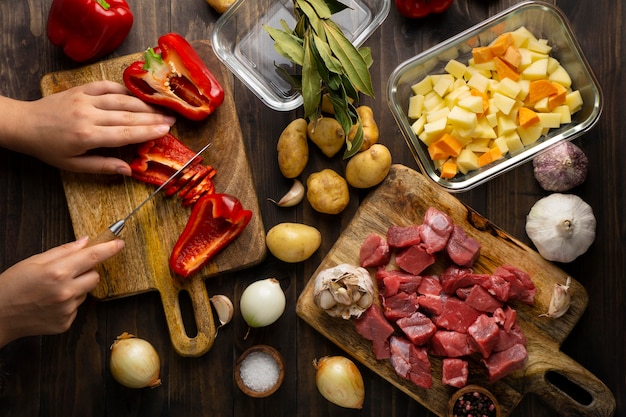Ah, green beans! These little bundles of green goodness are a staple in kitchens across the globe, and for good reason. They're versatile, nutritious, and when cooked properly, absolutely delicious. But let's face it, getting green beans just right can be a bit of a culinary tightrope walk. Overcook them, and you're left with a mushy mess. Undercook them, and you'll be chewing on something that's more like a twig than a vegetable.
Fear not, fellow cooks! I'm here to guide you through the process, sharing my tips and tricks for achieving perfect, vibrant green beans every single time. From selecting the best beans to mastering different cooking methods, I'll walk you through every step, ensuring you're equipped to impress even the most discerning palate.
Part 1: Getting Started - Selecting the Perfect Beans

Choosing the Right Green Beans
The journey to perfect green beans begins at the grocery store. The key here is to pick beans that are firm, vibrant green, and free from blemishes or any signs of wilting. If you find yourself staring at a bunch of limp, pale beans, put them back down and move on. You deserve better, and so does your dinner!
Personally, I often go for smaller, thinner beans. They tend to cook more evenly, making them a safer bet for consistent tenderness. But don't be afraid to experiment with different varieties! French beans, haricot verts, and runner beans all have their unique characteristics. See which ones you like best and remember to check the ends for any signs of dryness or discoloration.
Preparing the Beans for Cooking
Once you've got your perfect beans, it's time to give them a good wash. Run them under cold water, removing any lingering dirt or debris. Now, the big decision: whole or snapped? Some folks prefer to keep their beans whole, while others, like myself, prefer to snap them in half. This is especially useful for longer beans, ensuring they cook evenly. Plus, those little ends you trim off? Don't throw them away! They can be used to create a flavorful stock, adding extra depth to your cooking.
Part 2: Mastering the Art of Cooking

Boiling Green Beans: The Classic Method
Let's start with a classic: boiling. It's a simple and quick way to cook green beans, making it a go-to for many cooks. Fill a large pot with water, add a pinch of salt (for flavor!), and bring it to a rolling boil. Now, gently drop in your prepared beans and cook until they're tender-crisp, which usually takes around 3-5 minutes. Once they're done, immediately drain them and give them a quick splash of cold water to halt the cooking process and retain that vibrant green color.
Tips for Boiling Green Beans:
- Don't Overcrowd the Pot: Avoid cramming the pot, as the beans need room to cook evenly. If you've got a large batch, consider cooking them in batches to ensure optimal results.
- Fork Test: To check for doneness, gently pierce a bean with a fork. It should be tender but still have a slight crunch. If it feels mushy, you've overcooked it!
- A Touch of Brightness: For a little extra zing, try squeezing a bit of lemon juice into the boiling water. It adds a subtle brightness to the beans, complementing their natural flavor.
Steaming Green Beans: Gentle and Flavorful
If you're looking for a gentler cooking method that preserves the nutrients and flavor of your beans, steaming is the way to go. Place a steamer basket over a pot of boiling water, ensuring the water doesn't touch the basket. Add your green beans and steam until tender-crisp, which usually takes around 5-7 minutes.
Tips for Steaming Green Beans:
- The Right Basket: Choose a steamer basket that fits snugly in your pot to ensure efficient steaming.
- Salt the Water: Add a pinch of salt to the boiling water to infuse the beans with subtle flavor.
- Get Creative with Aromatics: For an extra layer of flavor, experiment with adding herbs or citrus peels to the steamer basket while the beans cook.
Roasting Green Beans: Bringing Out the Natural Sweetness
For a taste of roasted goodness, try roasting your green beans. Preheat your oven to 400°F (200°C) and toss your beans in a bowl with a good drizzle of olive oil, salt, and pepper. Spread them out in a single layer on a baking sheet and roast for 15-20 minutes, or until they're tender and slightly browned. The roasting process brings out the natural sweetness of the beans, making them a truly delicious side dish.
Tips for Roasting Green Beans:
- Space is Key: Don't overcrowd the baking sheet! The beans need space to roast evenly, achieving that desirable golden brown color.
- Flip for Evenness: Flip the beans halfway through the roasting time to ensure even cooking on all sides.
- Flavor Boost: For extra flavor, add other ingredients to your roasting pan, such as chopped garlic, onions, or fresh herbs. The possibilities are endless!
Sautéing Green Beans: Quick and Versatile
Sautéing is a fantastic option for a quick and flavorful side dish. Heat some olive oil in a large skillet over medium heat. Once the oil is shimmering, add your green beans and cook for 3-5 minutes, or until tender-crisp. Season with salt and pepper to taste.
Tips for Sautéing Green Beans:
- The Right Skillet: Use a large skillet to give your beans plenty of room to cook without crowding.
- Avoid Overcrowding: If you add too many beans to the skillet, they'll steam instead of sauté, resulting in a soggy outcome.
- Flavor Twists: Enhance the flavor by adding chopped garlic, onions, or your favorite herbs to the skillet.
Grilling Green Beans: A Smoky, Charred Delight
For a smoky, charred flavor, try grilling your green beans. Preheat your grill to medium heat, then toss the beans with olive oil, salt, and pepper. Thread them onto skewers and grill for 5-7 minutes, turning occasionally, until they're tender-crisp and slightly charred.
Tips for Grilling Green Beans:
- Clean Grates: Make sure your grill grates are clean before grilling to prevent any unwanted flavors from transferring to your beans.
- Metal Skewers: Use metal skewers for grilling, as they conduct heat better than wooden ones.
- Mix it Up: Add some excitement to your skewers by incorporating cherry tomatoes, onions, or mushrooms alongside your green beans.
Part 3: The Timing is Everything: How Long to Cook Green Beans?

Now, for the crucial question: how long do you cook green beans? The answer depends on the cooking method and the thickness of your beans. But the goal remains the same: tender-crisp, meaning they're still slightly firm to the bite, but not crunchy. It's a fine line, but with practice, you'll develop a feel for it. Here's a general guideline to get you started:
cooking times:
| Cooking Method | Time |
|---|---|
| Boiling | 3-5 minutes |
| Steaming | 5-7 minutes |
| Roasting | 15-20 minutes |
| Sautéing | 3-5 minutes |
| Grilling | 5-7 minutes |
Keep in mind that these are just estimates. Always check your beans for doneness by piercing them with a fork. They should be tender, but there should be a slight resistance. If they feel mushy, they're overcooked. Adjust the cooking time accordingly, based on your preference and the thickness of the beans.
Part 4: Flavoring Your Green Beans: From Simple to Spectacular
Once your green beans are cooked to perfection, it's time to add some flavor! There are endless possibilities, from simple seasonings to more complex sauces. Here are some ideas to get your creative juices flowing:
Simple Seasonings: The Basics for Flavor
- Salt and Pepper: The foundation of any good seasoning, salt and pepper bring out the natural flavors of the beans.
- Lemon Juice: A squeeze of lemon juice adds brightness and acidity, balancing the sweetness of the beans.
- Olive Oil: Drizzle some olive oil for a rich, smooth finish.
- Garlic Powder: A touch of garlic powder adds a warm, savory note.
- Onion Powder: Onion powder adds a subtle sweetness and complexity to the flavor profile.
Fresh Herbs: Aromatic Delights
- Parsley: A classic pairing for green beans, parsley adds a fresh, bright flavor.
- Dill: Dill brings a cool, slightly anise-like flavor.
- Mint: For a refreshing twist, add some chopped mint for a unique flavor profile.
- Basil: Basil adds a sweet, slightly peppery note, complementing the sweetness of the beans.
- Thyme: Thyme lends a savory, slightly woody flavor.
- Rosemary: Rosemary adds a robust, earthy flavor, perfect for roasted or grilled green beans.
Sauces: Elevating Your Green Bean Game
- Lemon Butter Sauce: A classic combination of lemon juice and melted butter, creating a tangy, rich sauce.
- Garlic and Herb Sauce: Combine minced garlic, fresh herbs, and olive oil for a fragrant and flavorful sauce.
- hollandaise sauce: This rich, emulsified sauce made with egg yolks, butter, and lemon juice is a luxurious topping for grilled or steamed green beans.
- Béarnaise Sauce: A variation of hollandaise with added tarragon and shallots, Béarnaise sauce adds a sophisticated touch to your green beans.
Don't be afraid to experiment with other ingredients as well! Toasted nuts, crumbled bacon, or a sprinkle of Parmesan cheese can add extra texture and flavor to your green beans.
Part 5: Serving Up Your Green Bean Masterpieces
Now, for the fun part: serving your delicious green beans! They're a versatile side dish that complements all sorts of meals, from grilled chicken and fish to roasted vegetables and hearty stews. Serve them warm, at room temperature, or even cold, depending on the occasion and your preference.
Serving Ideas: Making Your Green Beans Shine
- Classic Side Dish: Serve them alongside a main course, such as grilled salmon or roasted chicken, for a satisfying and flavorful meal.
- Salad Booster: Use them as a topping for salads, adding texture and a burst of fresh flavor.
- Soup and Stew Enhancer: Add them to soups or stews, for extra flavor and texture, especially in hearty winter dishes.
- Snack Time Delight: Enjoy them as a snack, either on their own or with a dip, like a creamy yogurt or a zesty vinaigrette.
Part 6: Storing and Reheating Leftovers
If you find yourself with leftover cooked green beans, don't fret! Store them in an airtight container in the refrigerator for up to 3-4 days. To reheat, gently warm them in a skillet or microwave. However, remember that reheated beans won't be as crisp as freshly cooked ones.
Part 7: Growing Your Own Green Beans: A Garden Delight
For those with green thumbs, growing your own green beans is a rewarding experience. It's easier than you might think, and you'll be able to enjoy fresh, homegrown beans all summer long. You can start them from seed indoors or direct sow outdoors once the soil has warmed up. They need a sunny spot and well-drained soil, and they'll need regular watering, especially during dry spells.
Tips for Growing Green Beans:
- Variety is Key: Choose a variety of green beans that's suited to your climate and growing conditions.
- Proper Spacing: Plant them in rows or hills, spacing them according to the variety's instructions to allow for optimal growth.
- Consistent Watering: Water them deeply and consistently, ensuring the soil remains moist but not soggy.
- Fertilizer for Growth: Fertilize them regularly, especially during the growing season, to promote healthy growth and a bountiful harvest.
- Harvest Regularly: Harvest the beans regularly to encourage further production and prevent the plants from becoming stressed.
Part 8: Green bean recipes: Unleash Your Creativity
Now, let's get inspired with some delicious green bean recipes:
1. Green bean salad with Dijon Vinaigrette:
This refreshing salad is perfect for a light summer meal. Combine cooked green beans with thinly sliced red onion, cherry tomatoes, and a tangy Dijon vinaigrette for a delightful combination of flavors and textures.
2. green bean casserole with Mushrooms and Croutons:
This classic comfort food is always a crowd-pleaser. Combine cooked green beans with sautéed mushrooms, creamy soup, and crispy croutons for a satisfying and flavorful dish.
3. Green Bean and Bacon Stir-Fry:
This quick and easy stir-fry is packed with flavor. Sauté green beans with crispy bacon, minced garlic, and your favorite Asian-inspired seasonings for a delicious and satisfying meal.
4. green bean fritters with Mint and Yogurt:
These crispy fritters are a delicious vegetarian option. Combine cooked green beans with chopped mint, flour, and spices, and fry them until golden brown. Serve them with a cool, creamy yogurt dip for a balanced and flavorful dish.
5. Green Bean and potato salad with Herbs:
This hearty salad is perfect for a picnic or potluck. Combine cooked green beans and potatoes with fresh herbs, a tangy vinaigrette, and a sprinkle of chopped nuts for a satisfying and flavorful salad.
FAQs: Answers to Your Burning Questions
1. Can I eat raw green beans?
It's generally not recommended to eat raw green beans, as they contain a toxin called "phasein" that can cause digestive upset. It's best to cook them thoroughly before consuming them.
2. Can I freeze green beans?
Yes, you can freeze green beans! To do this, blanch them in boiling water for 2-3 minutes, then plunge them into ice water to stop the cooking process. Drain them well and spread them out on a baking sheet to freeze. Once they're frozen solid, transfer them to a freezer-safe bag or container. Frozen green beans can last for up to 12 months in the freezer.
3. Can I use canned green beans instead of fresh?
You can use canned green beans if you don't have fresh ones, but they won't be as flavorful or nutritious as fresh green beans. canned beans are often overcooked, resulting in a less desirable texture. Drain and rinse the canned beans before using them in recipes.
4. What are the health benefits of green beans?
Green beans are a nutritional powerhouse! They're a good source of vitamins A, C, and K, as well as fiber and antioxidants. They're also low in calories and fat, making them a healthy and delicious addition to any diet.
5. How do I tell if green beans are spoiled?
Spoiled green beans will have a slimy texture, a dull color, and may have a slightly sour or off smell. If you notice any of these signs, it's best to discard the beans.
There you have it, a comprehensive guide to cooking fresh green beans. Now go forth and create culinary masterpieces, impressing your family and friends with your green bean expertise. And remember, if you have any questions or tips to share, don't hesitate to leave a comment below. Happy cooking!
Everyone is watching

Perfect Rice Every Time: The Ultimate Guide to Cooking Rice
Cooking TipsAs a self-proclaimed foodie, I've always been a bit obsessed with rice. It's the foundation of countless cuisi...

Ultimate Guide to Cooking the Perfect Thanksgiving Turkey
Cooking TipsThanksgiving. Just the word conjures up images of overflowing tables laden with delicious food, the scent of r...

The Ultimate Guide to Cooking Asparagus: Tips, Techniques, and Recipes
Cooking TipsAsparagus. The mere mention of this spring delicacy conjures up images of vibrant green spears, crisp and burs...

Can You Cook Spaghetti with Gasoline? (The Shocking Truth)
Cooking TipsWe've all seen those crazy internet trends. You know, the ones that make you wonder, "Did someone actually try...

Chorizo and Eggs Recipe: The Ultimate Guide
Cooking TipsRight, let’s talk about chorizo and eggs. You know, that classic Spanish dish that's always a winner. It's th...
